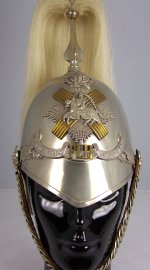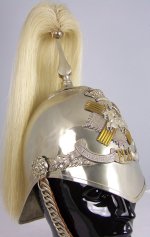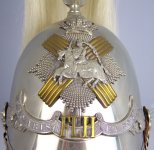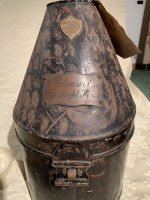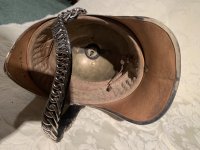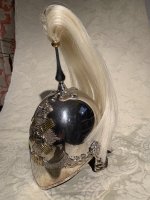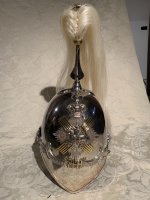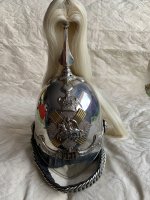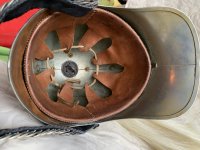RoyalScotsVols
Member
In March 1860, in the smoking room of Dysart House in Fife (the county area on the other side of the Forth from Edinburgh, commonly known for historic reasons as 'The Kingdom of Fife'), a number of gentlemen proposed to raise a regiment of volunteer cavalry. They were apparantly inspired by a newspaper description of the Duke of Manchester's military display at a recent levee but the idea may have been growing for some time following the enthusiastic response throughout the country to the national call for volunteers following the invasion scare of 1859.
In these circumstances, and as horses and fox-hunting were a significant part of their activities, the gentlemen of Fife were naturally eager to raise a cavalry regiment but in keeping with the trend at that time they elected to become Mounted Rifles. Lists of names of potential volunteers (most connected with farming) were drawn up at meets and markets and 4 troops were placed at Cupar, St Andrews, Kirkcaldy and Dunfermline with arrangements to share the local Rifle Corps armouries. Approval to form the unit was granted in June 1860 and the Fife Mounted Rifles (FMR) Volunteers was established.
The uniform and appointments were designed to be simple and practical with very little difference between officers and privates. In spite of the foot volunteers preference at that time for drab, neutral colours the FMR chose to wear red coats; this was possibly to echo the hunting coat and perhaps partly to assert their afinity with cavalry. The coat was quite plain with the only decoration being 4 buttons on a slashed cuff. The trousers were blue with a broad scarlet stripe and the headdress was a black leather helmet with a spike on top. Belts, sword slings and gloves were all of brown leather. An effort was made to reduce expense by including articles already in use; the saddle was the common riding pattern and the bridle a plain hunting double-bit. Fittingly for the 'Kingdom' the heraldic Thane of Fife was adopted as the regimental badge and he appeared on the waistbelt plate and the helmet, backed by a saltire and star. The moto was 'Pro Aris et Focis' which generally translates to 'for hearth and home'. This phrase is often employed as a moto to express devotion to one's family, country and traditions and is perhaps appropriate for the volunteers role. In time a white horsehair plume was added to the helmet to enhance the appearance and a web girdle replaced the waistbelt.
In 1870 the regiment applied for and was granted cavalry status with the new title of the Fife Light Horse (FLH) Volunteers and it was joined by a Troop of Forfar Light Horse across the Tay river and in 1883 a Perth Troop was formed. A metal dragoon helmet was introduced in 1896 to replace the leather helmet.
Pictured is an example of a FMR helmet from my collection - the body is in leather and, interestingly, although the chinchain has lost its backing, it is of a very open link style which appears to be correct for this unit. Also attached is a painting by Douglas N Anderson who I was fortunate enough to have met on many occasions. Douglas was a renowed historian and artist who was well known for his meticulous approach to uniform detail.
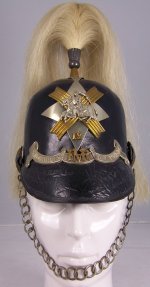
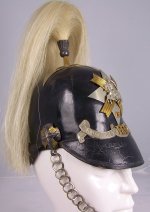
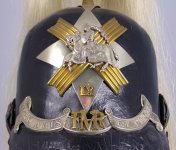

In these circumstances, and as horses and fox-hunting were a significant part of their activities, the gentlemen of Fife were naturally eager to raise a cavalry regiment but in keeping with the trend at that time they elected to become Mounted Rifles. Lists of names of potential volunteers (most connected with farming) were drawn up at meets and markets and 4 troops were placed at Cupar, St Andrews, Kirkcaldy and Dunfermline with arrangements to share the local Rifle Corps armouries. Approval to form the unit was granted in June 1860 and the Fife Mounted Rifles (FMR) Volunteers was established.
The uniform and appointments were designed to be simple and practical with very little difference between officers and privates. In spite of the foot volunteers preference at that time for drab, neutral colours the FMR chose to wear red coats; this was possibly to echo the hunting coat and perhaps partly to assert their afinity with cavalry. The coat was quite plain with the only decoration being 4 buttons on a slashed cuff. The trousers were blue with a broad scarlet stripe and the headdress was a black leather helmet with a spike on top. Belts, sword slings and gloves were all of brown leather. An effort was made to reduce expense by including articles already in use; the saddle was the common riding pattern and the bridle a plain hunting double-bit. Fittingly for the 'Kingdom' the heraldic Thane of Fife was adopted as the regimental badge and he appeared on the waistbelt plate and the helmet, backed by a saltire and star. The moto was 'Pro Aris et Focis' which generally translates to 'for hearth and home'. This phrase is often employed as a moto to express devotion to one's family, country and traditions and is perhaps appropriate for the volunteers role. In time a white horsehair plume was added to the helmet to enhance the appearance and a web girdle replaced the waistbelt.
In 1870 the regiment applied for and was granted cavalry status with the new title of the Fife Light Horse (FLH) Volunteers and it was joined by a Troop of Forfar Light Horse across the Tay river and in 1883 a Perth Troop was formed. A metal dragoon helmet was introduced in 1896 to replace the leather helmet.
Pictured is an example of a FMR helmet from my collection - the body is in leather and, interestingly, although the chinchain has lost its backing, it is of a very open link style which appears to be correct for this unit. Also attached is a painting by Douglas N Anderson who I was fortunate enough to have met on many occasions. Douglas was a renowed historian and artist who was well known for his meticulous approach to uniform detail.




Last edited:

